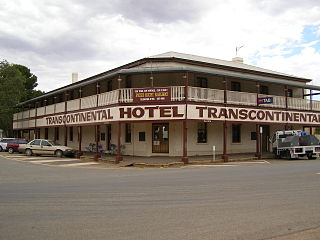
Port Augusta is a small coastal city in South Australia about 310 kilometres (190 mi) by road from the state capital, Adelaide. Most of the city is on the eastern shores of Spencer Gulf, immediately south of the gulf's head, comprising the city's centre and surrounding suburbs, Stirling North, and seaside homes at Commissariat Point, Blanche Harbor and Miranda. The suburb of Port Augusta West is on the western side of the gulf on the Eyre Peninsula. Together, these localities had a population of 13,515 people in the 2021 census.

The Ghan is an experiential tourism-oriented passenger train service that operates between the northern and southern coasts of Australia, through the cities of Adelaide, Alice Springs and Darwin on the Adelaide–Darwin rail corridor. Operated by Journey Beyond Rail Expeditions, its scheduled travelling time, including extended stops for passengers to do off-train tours, is 53 hours 15 minutes to travel the 2,979 kilometres (1,851 mi). The Ghan has been described as one of the world's great passenger trains.

Quorn is a small town and railhead in the Flinders Ranges in the north of South Australia, 39 kilometres (24 mi) northeast of Port Augusta.

Pichi Richi Railway is a 39 kilometres narrow-gauge heritage railway in the southern Flinders Ranges of South Australia between Quorn and Port Augusta. For much of its length the line lies in the picturesque Pichi Richi Pass, where the line was completed in 1879 as work proceeded north to build a railway to the "Red Centre" of Australia – the Central Australia Railway.

The former Central Australia Railway, which was built between 1878 and 1929 and closed in 1980, was a 1241 km (771 mi) 1067 mm narrow gauge railway between Port Augusta and Alice Springs. A standard gauge line duplicated the southern section from Port Augusta to Maree in 1957 on a new nearby alignment. The entire Central Australia Railway was superseded in 1980 after the standard gauge Tarcoola–Alice Springs Railway was opened, using a new route up to 200 km to the west. A small southern section of the original line between Port Augusta and Quorn has been preserved as the Pichi Richi Tourist Railway.

The first railway in colonial South Australia was a line from the port of Goolwa on the River Murray to an ocean harbour at Port Elliot, which first operated in December 1853, before its completion in May 1854.

The Commonwealth Railways were established in 1917 by the Government of Australia with the Commonwealth Railways Act to administer the Trans-Australia and Port Augusta to Darwin railways. In 1975, all assets were acquired by the Australian National Railways Commission, branded as Australian National Railways and subsequently Australian National, trademarked as AN.

The Steamtown Peterborough Railway Preservation Society Inc. was a not-for-profit incorporated society that operated a heritage steam railway from Peterborough, South Australia, north along a section of the Peterborough to Quorn railway line, between 1977 and 2002. The society based its operations on the former South Australian Railways roundhouse at Peterborough and purpose-built sheds and yard at Peterborough West.
Railmotor is a term used in the United Kingdom and elsewhere for a railway lightweight railcar, usually consisting of a railway carriage with a steam traction unit, or a diesel or petrol engine, integrated into it.

The Commonwealth Railways NC class consisted of two diesel-hydraulic locomotives built by Clyde Engineering, Granville, New South Wales in 1956. The Lakewood Firewood Company, Kalgoorlie was the first owner; the Commonwealth Railways purchased them in 1965. They ceased revenue service in the early 1980s.

The WAGR W class is a class of 4-8-2 steam locomotives operated by the Western Australian Government Railways (WAGR) between 1951 and 1972.

The Commonwealth Railways NSU class was a class of diesel-electric locomotives built in 1954 and 1955 by the Birmingham Railway Carriage and Wagon Company, England, for the Commonwealth Railways to be deployed on the narrow-gauge Central Australia Railway and North Australia Railway.

The 500 class were a class of South Australian Railways diesel shunter locomotives built at Islington Railway Workshops between 1964 and 1969.

The Commonwealth Railways NB class originated in a shipment of four 0-6-0, 1067 millimetres gauge, saddle tank steam locomotives built by the Vulcan Iron Works of Wilkes-Barre, Pennsylvania. They were imported to Australia in 1916 for construction work at the naval base at Henderson, Western Australia. Their tractive effort was 9500 pounds.

The South Australian Railways W and Wx class was a class of 2-6-0 steam locomotives operated by the South Australian Railways. Some were used by the Commonwealth Railways in the Northern Territory and by contractors.

Port Augusta railway station is a rail station located on the Adelaide-Port Augusta railway line in Port Augusta, South Australia.

Quorn railway station was located on the Central Australia Railway, and also the Peterborough-Quorn railway line serving the South Australian town of Quorn.
Hammond is a town and locality in the Australian state of South Australia located in the southern Flinders Ranges.
The Peterborough–Quorn railway line was a 3 ft 6 in railway line on the South Australian Railways network. Located in the upper Mid North of South Australia, it opened from Peterborough to Orroroo on 23 November 1881, being extended to Quorn on 22 May 1882.

The NDH class railcars are a class of self propelled diesel-hydraulic railcars designed by Commonwealth Engineering and built by the Gloucester Railway Carriage & Wagon Company in England for the Commonwealth Railways, Australia in 1954. They were known as Gloucester railcars.

















